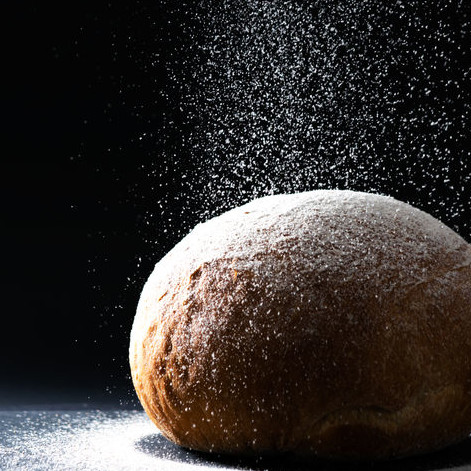Triticale Flour
What is Triticale Flour?
Triticale flour is a powder made from a hybrid grain of rye and wheat. The grain is larger and longer than wheat grain. Triticale has the functional properties of wheat and the environmental adaptability of rye.
In the baking industry, it is used as a partial substitute for wheat flour in breads, tortillas, cakes, cookies.1 Triticales flour is available as:
- Hard
- Semi-hard
- Soft
- Blends
Origin
Triticale (X Triticosecale) is a hybrid grain obtained from crossing rye (Secale) and wheat (Triticum) grains. The earliest attempt to develop triticale attributed to the Scottish scientist A.S Wilson was not very successful. In 1898, an Australian agronomist named W. Farrer successfully produced triticale by crossing Willet Wheat with Alabama’s rye.2
Today’s triticale is cultivated mostly in Europe and in very limited areas in the US.2
Function
Triticale flour has several functions in baked goods, partially similar to those found in wheat and rye flours:
- High alpha-amylase activity: an advantage for malting and brewing but not for breadmaking
- Taste: mostly earthy, sweet and nutty
- Color: provides subtract for Maillard’s browning reaction
- Structure: aids in structure development and mechanical stability of baked goods
- Water absorption: helps support dough stability and handling
Nutrition
The nutritional composition per 100 g:
| Component | g |
| Carbohydrate | 60 – 76 |
| Protein | 10 – 16 |
| Water | 10 – 12 |
| Ash | 1.3- 2.2 |
| Fat | 1.5 – 2.09 |
Triticale flour surpasses wheat flour in its protein and lysine content and has better digestibility, minerals and amino acids balance.
Commercial production
The following process describes the commercial production of triticale flour:2
- Cleaning: grain separation from contaminants like weed, seeds or stones by sieving and air blowing through several screens
- Tempering: addition of water (up to 16%) to increase the grain moisture content and settling time to balance moisture content
- Breaking: conditioned grains pass through milling rolls to break the hulls followed by sieving
- Separation: different particle size powder is separated using sieve screens of different sizes
- Reduction: the remaining particles are milled again to further reduce their size
- Release: further sieving to recover the fine flour
Application
Few quality differences are generally observed in baking qualities of triticale and rye flours. It can be used most adequately in making rye or American mixed wheat-rye breads. Other applications include tortillas, cookies and cakes.
Generally, triticale flour produces weak doughs due to its inferior gluten strength and high alpha-amylase activity. The following table shows a comparison of triticale functional properties with wheat:2
| Properties | Level |
| Starch granule size | Slightly larger |
| Water binding capacity | Highly effective |
| Water-soluble protein | Higher |
| Gluten quality | Lower efficiency |
| Viscosity/elasticity | Moderate |
| Dough stickiness | Higher |
| Gas retention | Lower |
| Bread | |
| Texture | Coarser |
| Flavor | Stronge, nutty, sweet |
| Shelf life | Shorter |
Blending of triticale and wheat during the milling process in a ratio of 75:25 is highly recommended to improve quality and yield of the flour.1
Typical baking conditions for triticale flour-containing blends:1,3,4
| Baked goods | Formulation | Conditions or additives |
| Bread | 90% Triticale flour, 10% rye flour with preferment | Baking temperature 235-245 °C (455-473 °F). |
| Layer cake |
100% Triticale flour 20-50% Triticale flour with an emulsifier |
Proper chlorine treatment of flour |
| Tortillas | 50-100% Triticale flour | Addition of 2% vital gluten |
Regulations
According to the FDA Guidance for Industry, triticale flour is a gluten-containing grain and is not suitable for celiacs and gluten allergy sufferers.5
In the EU, triticale is allowed for human consumption and is not a subject of the EU intervention.
References
- Arendt, E. K and Zannini,E. Cereal grains for the food and beverage industries. 1 st ed., Elsevier, 2013.
- Wrigley, C., Batey, I and Miskelly, D. Cereal grains: assessing and managing quality. Elsevier, 2017.
- Rosentrater, K.A and Evers, A.D. Kent’s Technology of Cereals: An introduction for students of food science and agriculture. 5 th ed.,Elsevier, 2018.
- Caballero, B., Trugo,L and Finglas, P. “Encyclopedia of food sciences and nutrition: Volumes 1-10.” Encyclopedia of food sciences and nutrition: Volumes 1-10. Ed. 2, 2003.
- Food and Drug Administration (FDA). US Department of Health and Human Services. “Search for FDA Guidance Documents – Guidance for Industry: Gluten-Free Labeling of Foods; Small Entity Compliance Guide.” U S Food and Drug Administration Home Page. 1 July 2016. https://www.fda.gov/RegulatoryInformation/Guidances/ucm402549.htm. Accessed 14 August 2020.


